Questions shape search engines, communities, and even businesses, but who owns the answers?
Searchable, structured, and self-sustaining, modern Q&A platforms function more like software products than social networks.
In this guide, we unpack how to build a scalable, high-utility Q&A website that becomes a trusted source within your niche. You’ll learn about essential features like user roles, ranking logic, moderation systems, and UX architecture, as well as the trade-offs in design, technology, and community management.
Finally, we show how Codica’s development process helps you launch faster, with the infrastructure to grow sustainably.
Q&A website definition and overview
A Q&A (Question-and-Answer) website is a structured digital platform designed to capture, organize, and surface knowledge in response to user-generated questions. Its primary goal is not conversation, but clarity and discoverability of verified information.
Core purpose
Unlike forums or chat-based platforms, which prioritize discussion, a Q&A site focuses on:
- Precision. Delivering the best possible answer to a clearly defined question.
- Persistence. Preserving useful knowledge for future users.
- Searchability. Making it easy to find the right information fast.
In essence, it transforms isolated questions into permanent knowledge assets.
How it works behind the scenes
Though the user experience may feel simple, effective Q&A platforms are supported by:
- Defined roles (askers, answerers, moderators, admins).
- Content structuring (questions, answers, comments, tags, votes).
- Reputation systems that reward quality participation.
- Algorithms that rank content based on relevance, accuracy, and community trust.
This creates a dynamic system where content continuously improves through community input and algorithmic refinement.
The flywheel effect of quality
A successful Q&A platform becomes self-reinforcing:
- The more useful answers it contains, the more users it attracts.
- More users mean more contributions, better answers, and faster responses.
- Over time, the platform becomes an authoritative knowledge hub within its domain.
This loop is only possible when the architecture supports quality control, relevance ranking, and duplication management at scale.
The balance every Q&A site must achieve
To perform well long-term, a Q&A website must balance:
- Structure vs. flexibility, rigid enough to stay organized, but open to organic growth.
- Control vs. openness, allowing user freedom while preventing low-quality content.
- Usability vs. depth, accessible to newcomers, yet robust for power users.
Each layer of the platform, UX, moderation, architecture, must align with the core goal: turning user interaction into valuable, lasting knowledge.
Real-world Q&A examples: What sets them apart
Let’s examine four standout Q&A platforms: Stack Overflow, Quora, Reddit, and Stack Exchange, that each tackled the core challenge of transforming user inquiries into reliable knowledge hubs through distinct approaches to moderation, personalization, and community governance.
Analyzing their divergent strategies will reveal adaptable design patterns and incentive structures for your own Q&A site.
1. Stack Overflow
Stack Overflow targets software developers and IT professionals with a laser focus on code-level questions and precise solutions.
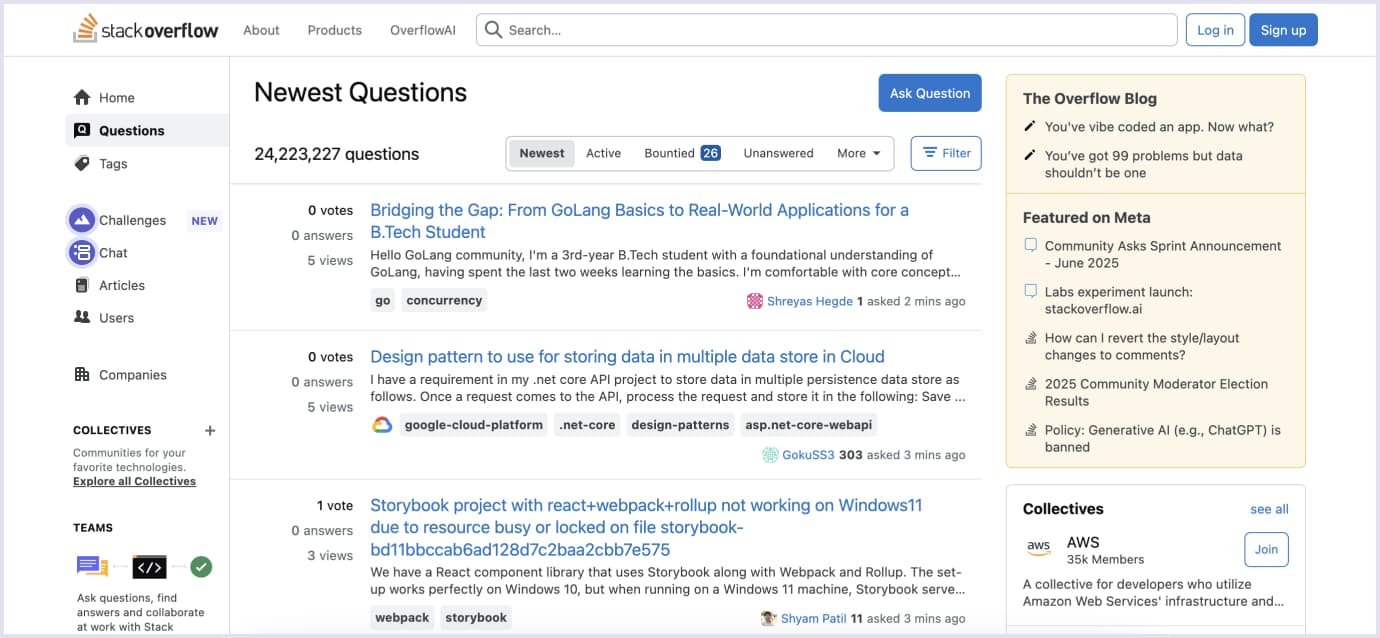
Source: Stack Overflow
Every question and answer goes through community moderation and vote-based ranking, ensuring that the most accurate responses rise to the top. A robust reputation system incentivizes experts to contribute high-quality content consistently.
This model excels when factual correctness and technical rigor are non-negotiable.
2. Quora
Quora covers a vast spectrum of topics by encouraging detailed, narrative-style answers from a diverse user base, including industry leaders and subject-matter experts.
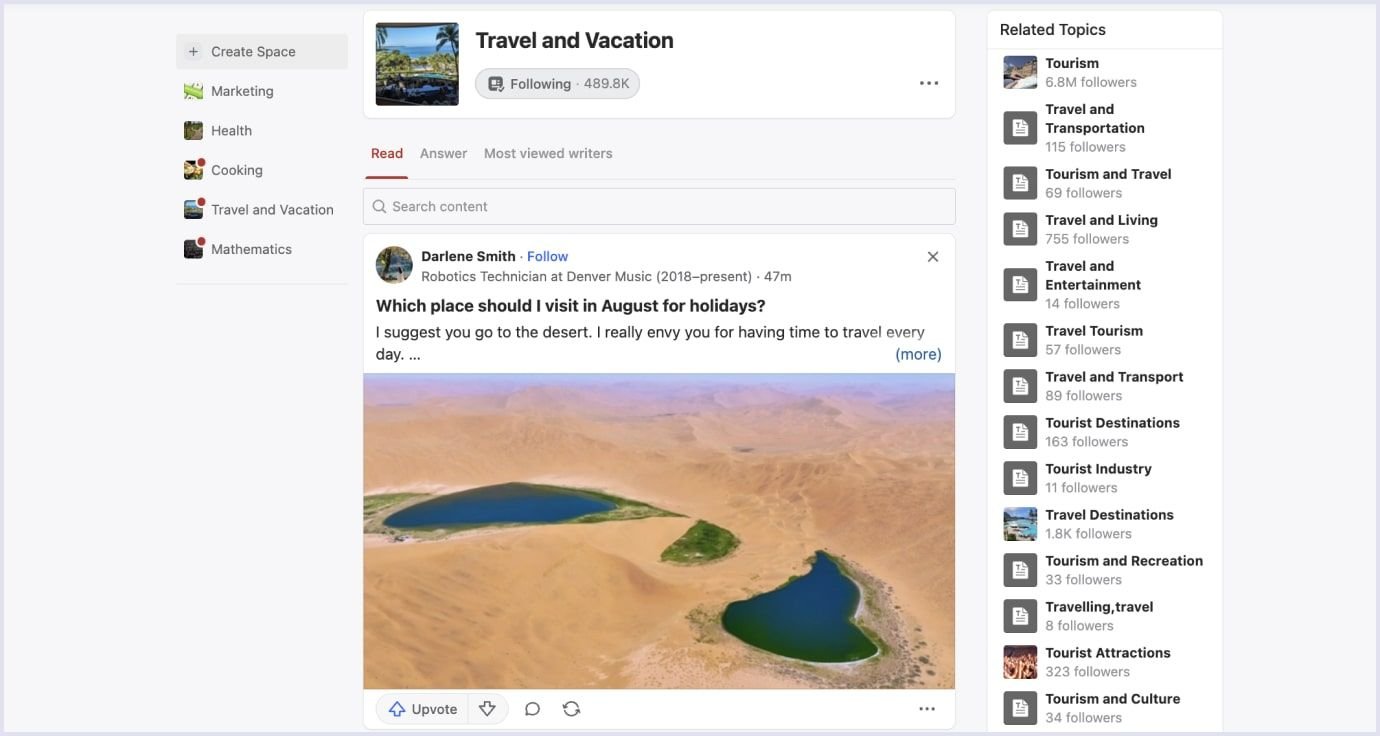
Source: Quora
Its algorithmic feed personalizes content discovery, prioritizing questions and answers that align with each user’s interests and network. The platform’s emphasis on storytelling and personal insight makes it ideal for explorations of philosophy, career advice, and lifestyle topics.
Quora demonstrates how narrative depth and personalization can drive sustained engagement.
3. Reddit
Reddit’s Ask subreddits (e.g., AskReddit, AskScience) operate as decentralized Q&A forums, where moderation and content curation are largely crowd-driven.
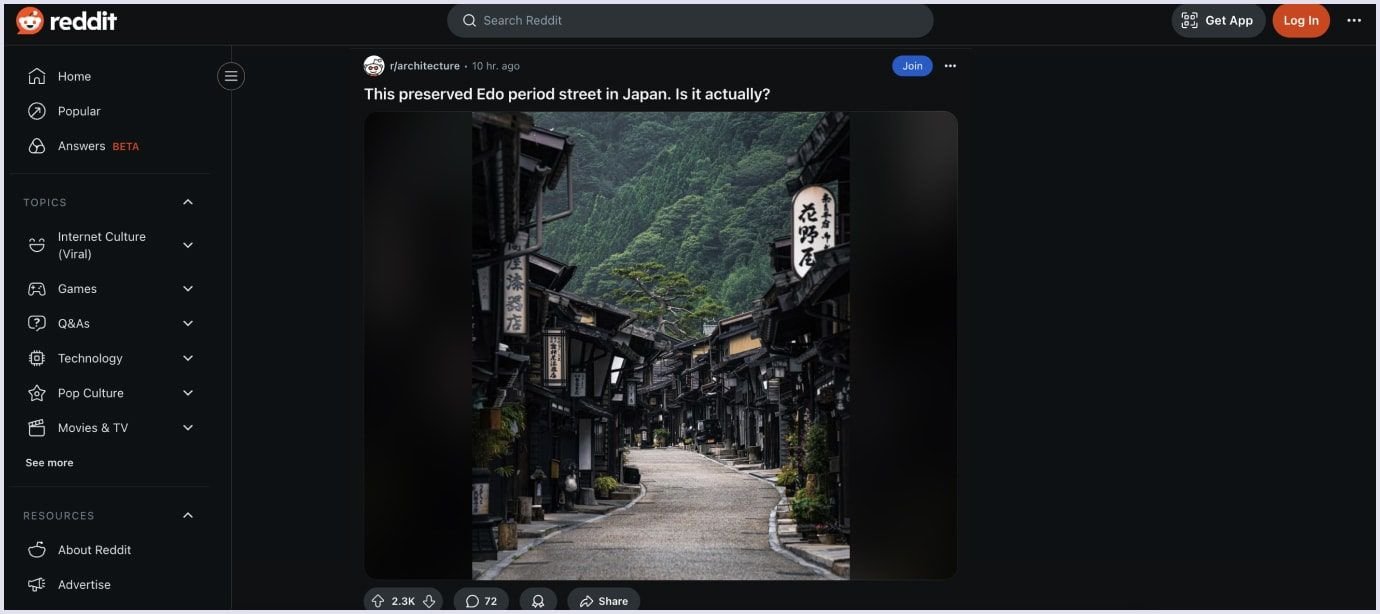
Source: Reddit
Users post open-ended or niche questions and receive a mixture of expert, anecdotal, and opinionated answers in real time. The community-voting mechanism surfaces popular responses, but the format allows for more informal, exploratory discussion than traditional Q&A sites.
This approach shines when you need high engagement and rapid, diverse input.
4. Stack Exchange
The Stack Exchange network extends the Stack Overflow framework across dozens of specialized verticals, such as mathematics, design, and law, while maintaining a unified architecture and quality standards.
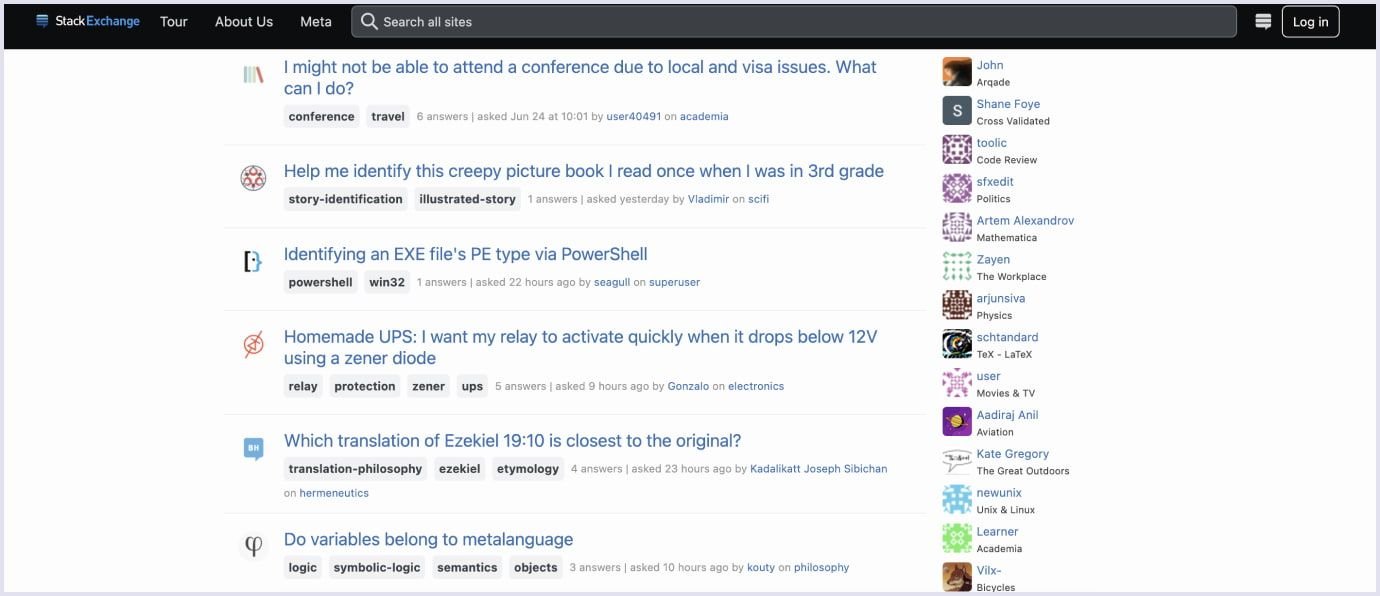
Source: Stack Exchange
Each site enforces strict posting guidelines, tag hierarchies, and peer-review processes to keep content focused and authoritative. Shared reputation points and badges transfer across the network, rewarding cross-disciplinary expertise.
This structure is a blueprint for scaling a single Q&A engine into a multi-category knowledge ecosystem.

Online Q&A platform: pros and cons
Q&A platforms can become both community engines and evergreen knowledge stores, but only if you navigate their built-in trade-offs. Below, we unpack the genuine upsides and often-overlooked challenges of launching a Q&A site in 2025.
Pros: Strategic advantages of Q&A platforms
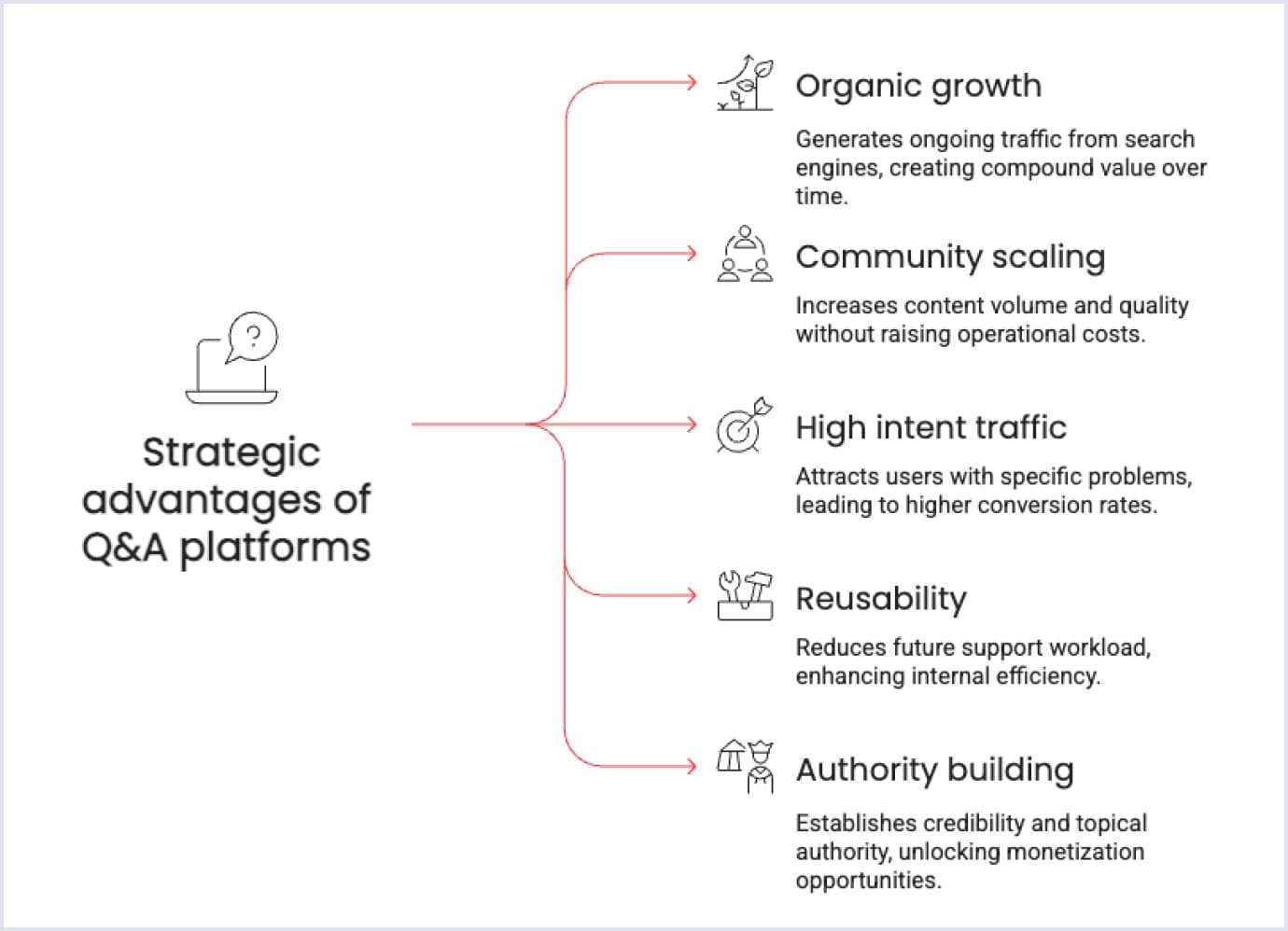
1. Organic growth through evergreen content
When structured properly, Q&A content generates ongoing traffic from search engines, long after the original post. Each question acts as an indexed node in a growing knowledge tree, creating compound value over time.
2. Community-powered scaling
As the user base grows, so does the volume and quality of answers, without directly increasing your operational cost, a core benefit of UGC (user-generated content) models. Moderation, tagging, and even quality control can become partially decentralized.
3. High intent, low bounce traffic
Visitors typically arrive on Q&A sites with a very specific problem and a high readiness to engage. Unlike casual browsers, these users often convert, whether to registration, purchases, or contributions.
4. Reusability and internal search efficiency
Each resolved question reduces future support workload, a key win for internal or B2B platforms using Q&A models as knowledge bases or customer self-service layers.
5. Positioning as an authority
Over time, a well-moderated and content-rich Q&A platform builds credibility and topical authority, both in the eyes of users and search algorithms. This unlocks reputational advantages and opens doors for monetization, partnerships, and press exposure.
Cons: Strategic and operational challenges
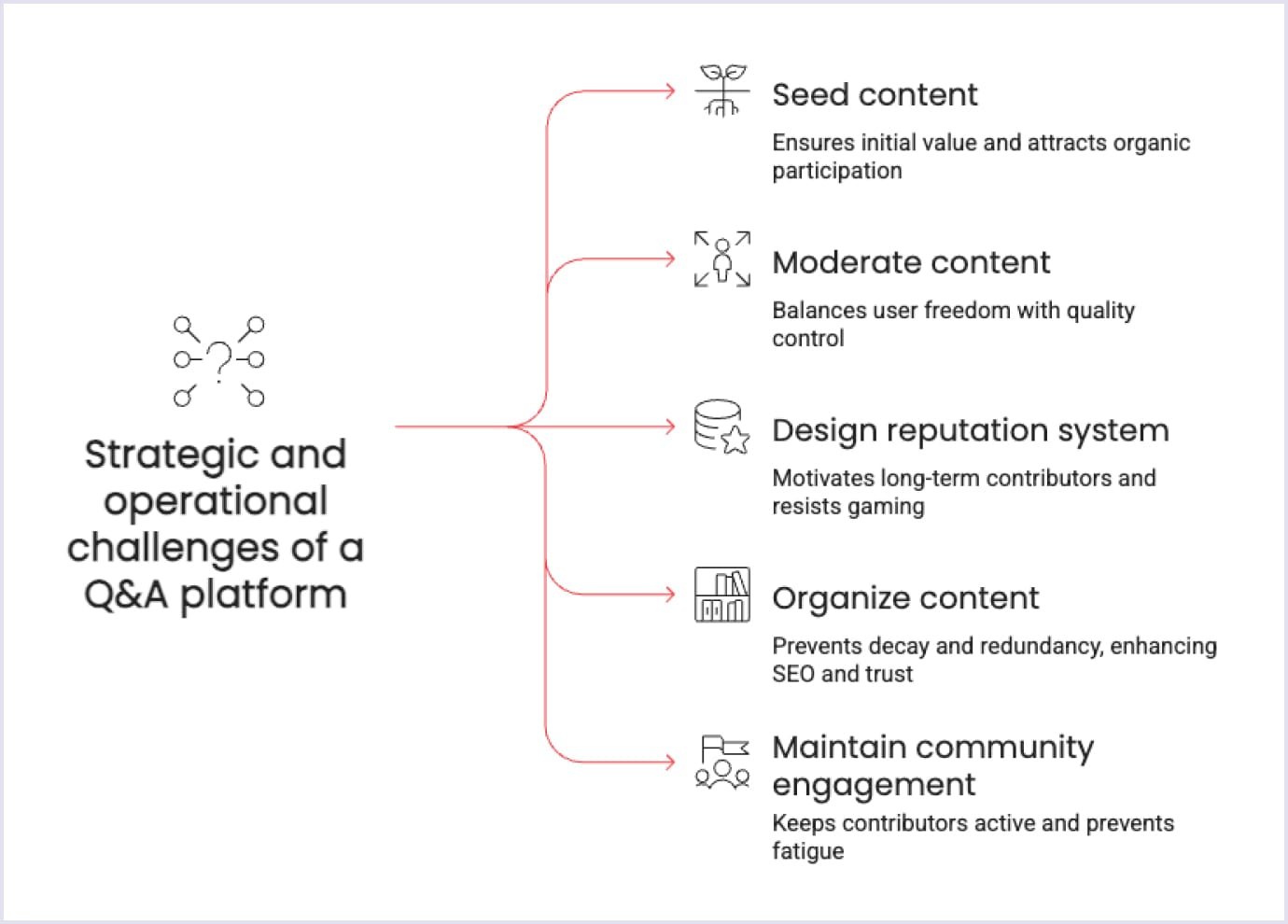
1. Cold start problem
A Q&A platform with no content or community is a dead zone. You need to seed both high-quality questions and credible answers early on, often manually, to signal value and attract organic participation.
2. Quality vs. quantity dilemma
Too much user freedom can result in spam, duplicate questions, or vague content. Too many restrictions, and new users disengage. You’ll need a fine-tuned moderation strategy supported by UX, not just rules.
3. Reputation system complexity
Designing a fair and effective reputation system is non-trivial. It must motivate long-term contributors, resist gaming, and work across both niche experts and casual users, all without overwhelming newcomers.
4. Content decay and redundancy
Without rigorous taxonomy and deduplication, your platform risks becoming a messy archive of similar but scattered answers. This erodes both SEO performance and user trust over time.
5. Community fatigue
As a platform grows, experienced users may become less responsive or disengaged, especially if incentives plateau. Maintaining a sense of progress and reward is key to keeping contributors active over the long term.
Q&A websites are scalable by nature, but not automatically self-sustaining. To reap the benefits, you’ll need to actively invest in seeding, moderation, content structure, and incentive alignment, especially in the first 6–12 months post-launch.
Step-by-step guide to building a Q&A website that works
Creating a Q&A platform is about building an interactive, scalable product that can handle structured content, dynamic user roles, community logic, and long-term sustainability.
Whether your goal is a public-facing knowledge hub or a private enterprise tool, the development process must be rigorous, iterative, and strategically led from day one.
Here’s a complete step-by-step breakdown of how to build a Q&A website, from initial research to ongoing support, based on Codica’s proven methodology as a custom software development company.
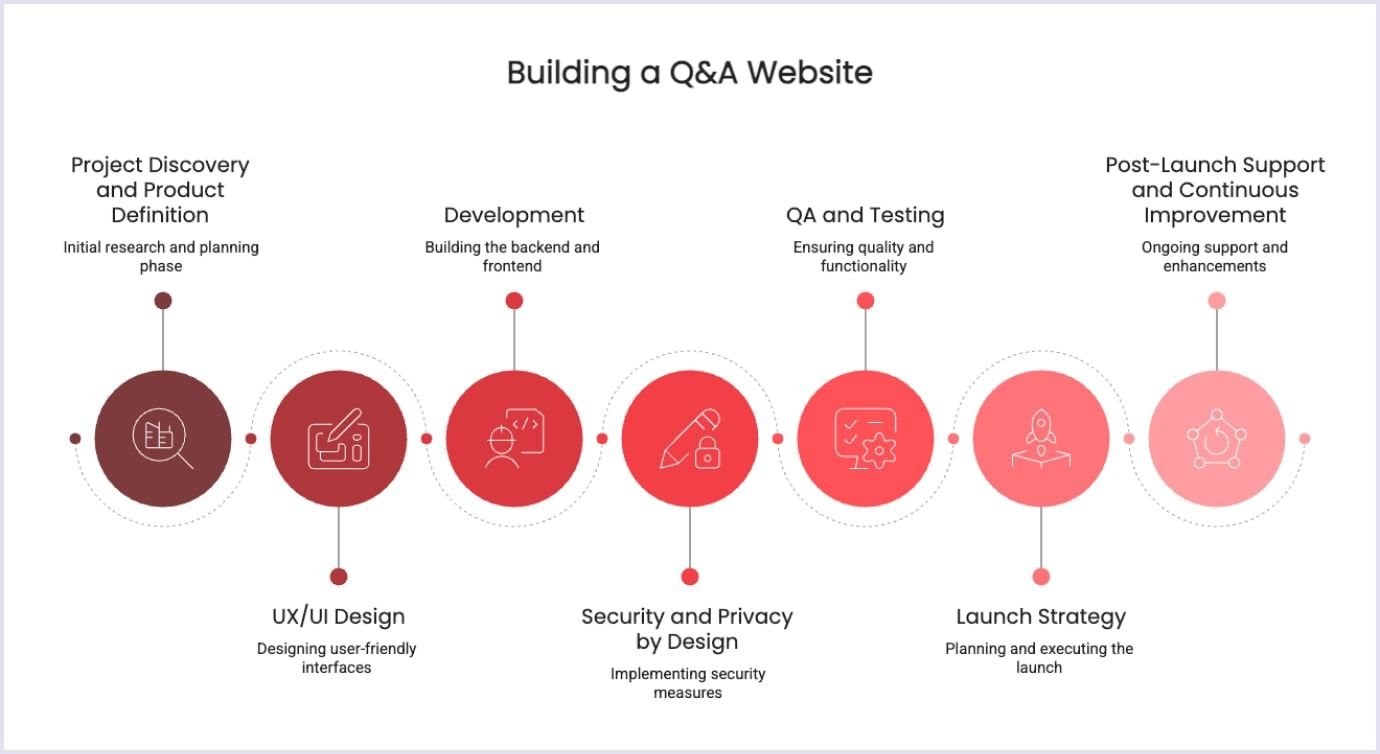
Step 1: Project discovery and product definition
Before any code is written, the first step is discovery. Project discovery phase is all about turning assumptions into validated decisions.
What happens here:
- Market and competitor research;
- Audience persona development;
- Feature set prioritization (must-haves vs. nice-to-haves);
- Technical feasibility analysis;
- Platform goals and KPIs definition.
At Codica, we run structured product discovery workshops with our clients to clarify product vision, define user journeys, and select a scalable tech stack early, this ensures the Q&A platform you build matches real-world user needs, not just internal ideas.
Step 2: UX/UI design
Designing a Q&A site isn’t about aesthetics alone. It’s about making complex logic feel simple, for both contributors and readers.
Key elements:
- User roles (askers, answerers, moderators, admins) mapped to permissions;
- Intuitive information hierarchy (categories, tags, filters, sorting);
- Answer ranking UX and voting mechanics;
- Mobile-first, responsive layouts;
- SEO-optimized structure (URLs, schema markup, structured data).
Codica’s product designers work with real-world UX data to ensure that question submission, answer discovery, and profile engagement are frictionless, especially for first-time users, through our tailored UI/UX design services that prioritize clarity, usability, and conversion.
Step 3: Development (backend, frontend, and integrations)
With validated requirements and designs in place, the next stage is development, turning static prototypes into a functional, scalable product.
Backend priorities:
- Role-based access control;
- Question-answer-comment-vote relational logic;
- Tagging, reporting, moderation queues;
- Reputation and gamification engines;
- RESTful or GraphQL API structure for extensibility.
Frontend priorities:
- Real-time content updates (WebSockets or polling);
- Rich-text editors for content input;
- Smooth UI state management (using React, Vue, etc.);
- Accessibility standards (WCAG 2.1 compliance).
At Codica, we specialize in modular, maintainable codebases that support rapid iteration and feature expansion, especially crucial for Q&A systems that may evolve into multi-category or multilingual platforms.
Step 4: Security and privacy by design
Q&A platforms store personal data, track behavior, and often host user-generated content, security is not optional.
Implementation essentials:
- GDPR/CCPA compliance;
- Secure authentication (OAuth, 2FA);
- Anti-spam and abuse prevention (rate limiting, IP bans, automated moderation);
- Role-level content access restrictions;
- Data encryption and secure backups.
Codica ensures that data handling and platform integrity are baked into every layer of the system, not bolted on later.
Step 5: QA and testing
Every release must be tested like it’s production, because that’s exactly where your users will test it for you.
QA strategy includes:
- Automated unit and integration testing;
- Manual interface and usability testing;
- Mobile and cross-browser compatibility;
- Load testing under peak scenarios;
- Regression testing on each release.
Our QA team at Codica works in parallel with developers to ensure every feature is testable, traceable, and bug-free from MVP to post-launch, delivering reliable results through our comprehensive quality assurance services.
Step 6: Launch strategy
Even the best platform can fail without a proper rollout. Your launch plan needs to balance technical readiness with real-world traction.
What to prepare:
- Beta or soft-launch environment;
- Pre-seeded content to overcome the cold start problem;
- Email onboarding flows and contributor incentives;
- Launch-day monitoring and support playbooks.
Codica supports clients during and after launch with real-time analytics hooks, server monitoring, and deployment orchestration, so you scale predictably, not reactively.
Step 7: Post-launch support and continuous improvement
A Q&A platform is never "done", it grows, evolves, and improves through feedback loops.
What happens next:
- Collect user data to guide roadmap decisions;
- Implement feature requests and refinements;
- Monitor system health (CPU/memory/disk, uptime, traffic surges);
- Add new verticals, localization, or integrations.
At Codica, we offer long-term support and growth-driven development services to help you pivot, scale, or refine the platform based on how users actually interact with it.
Building a Q&A website is about creating the right structure, incentives, and experience for your unique users and use case. From the first workshop to live product and beyond, Codica helps you translate complex logic into intuitive systems, fast, securely, and built to scale.

Monetization strategies for your Q&A website
Building a powerful Q&A website is just the first half of the journey, the second is turning that engagement into sustainable revenue.
Since Q&A platforms sit at the intersection of content, community, and credibility, they offer unique monetization opportunities beyond the typical ad-based models. The key lies in aligning monetization with the platform’s user value, not interrupting it.
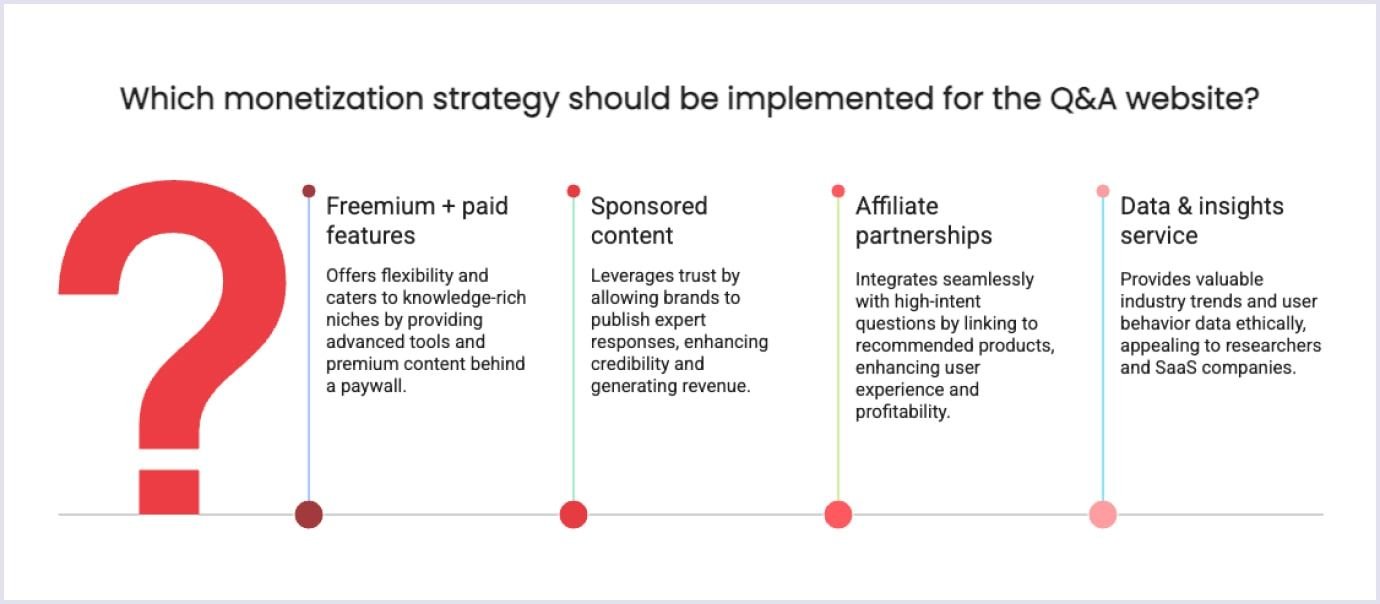
Below are proven and emerging strategies to monetize a Q&A platform in ways that enhance, not dilute, the user experience.
1. Freemium + paid features
One of the most flexible models, the freemium approach keeps core Q&A functions open while gating advanced tools or premium content behind a paywall. This is ideal for knowledge-rich niches such as law, medicine, finance, or tech.
Monetizable features might include:
- Access to verified or expert-only answers;
- Priority question placement or “fast track” responses;
- Advanced search filters or analytics;
- Profile customization and visibility boosts.
Platforms like Stack Overflow for Teams use this model effectively for internal enterprise knowledge bases.
2. Sponsored content and expert answers
When trust is the product, brands will pay to earn a credible voice. Offering businesses the chance to publish expert responses, clearly marked as sponsored, can create high-quality, relevant content while generating revenue.
Examples include:
- Verified professionals answering under a branded profile;
- Educational or how-to posts linked to a product (with full transparency);
- Sponsored AMAs (Ask Me Anything) with subject-matter experts.
Codica can help integrate this into your platform architecture using role-based access and moderation controls that flag or feature verified sponsors.
3. Affiliate partnerships via answer linking
Q&A sites often become decision-making tools. When users ask, “What’s the best software for X?” or “How do I solve Y?”, linking to recommended tools, courses, or products via affiliate programs is both helpful and profitable.
Key considerations:
- Contextual relevance matters more than volume;
- Transparency (e.g., “this link supports our platform”) builds trust;
- Smart tagging systems can suggest affiliate-eligible content.
This model blends seamlessly into the flow of high-intent questions, especially with strong tagging and SEO.
4. Data & insights as a service (ethically)
If anonymized properly, aggregated Q&A content can reveal industry trends, pain points, and user behavior valuable to researchers or SaaS companies.
Consider:
- Analytics dashboards for B2B partners;
- Reports sold to publishers or educational institutions;
- API access for third-party applications.
Codica prioritizes privacy-first architecture to ensure compliance with GDPR and CCPA while enabling ethical data monetization pathways.
The best Q&A website monetization strategy depends on your niche, audience maturity, and platform goals. A public health Q&A platform may thrive on partnerships and grants, while a tech-focused platform might lean toward affiliate links and talent matching.
Why choose Codica to build a Q&A website
Codica is a full-cycle software development agency. Meaning, we build your product from scratch and make sure everything works properly after its launch.
None of this would be possible without our dedicated specialists:
- UX/UI designers;
- Project managers;
- Software developers;
- DevOps engineers;
- QA engineers.
Each of them has profound knowledge in their field and experience in working on large-scale software products. Before creating a question and answer website, Codica team will analyze the input data and prepare a well-detailed project scope.
With the best programming tools like Ruby and Ruby on Rails, you will ensure all your functionality works perfectly. Rails framework offers many features that enable rapid prototyping. Along with simple automated testing, it makes Rails an advantageous framework.
Then, we will build an MVP. Based on collected feedback from early adopters you will know precisely what to add in future iterations.
A partnership with Codica as an MVP development agency doesn't end here. Once your product is launched, Codica Team will be taking care of a software state. If any bugs occur, we will fix them shortly after.
To create a question and answer website for a wider mobile audience, consider building a progressive web application (PWA). Such a solution will let users stay connected to your Q&A platform with poor Internet due to pre-caching. Besides, PWA doesn't take much space on a user's device.
Key reasons why we see progressive web app development services as part of a successful mobile strategy:
- Fast-loading pages;
- Push notifications;
- Cross-browser compatibility;
- Offline usability.
If you want to know more about the PWA technology, we are happy to share our ready works. Learn about the mobile-friendly app we delivered in our job matching service case study.
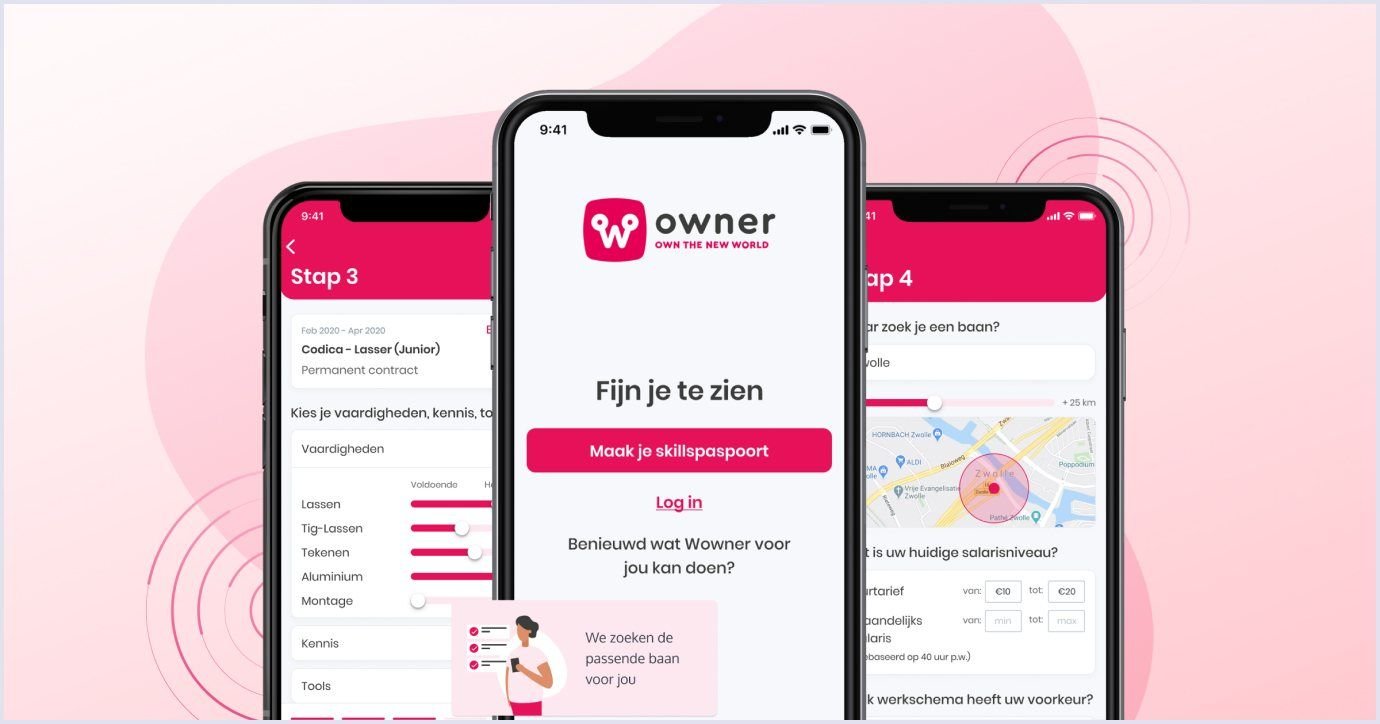
How much does it cost to build a Q&A website?
The total cost of building a Q&A website depends on the platform’s scope, feature set, tech stack, and development approach. At Codica, we follow a structured process to deliver scalable and secure platforms while optimizing for speed, quality, and long-term maintainability.
Below is a breakdown of typical costs associated with building a custom Q&A website using Codica’s full-cycle development approach.
| Costs of creating a website similar to Quora | ||
| Features | Time, hours | Cost (50$/h) |
| Design | ||
| UX development | 64 | $3,200 |
| UI development | 96 | $4,800 |
| Architecture | ||
| Project setup | 24 | $1,200 |
| DB structure | 32 | $1,600 |
| Integrations | ||
| Payment (Stripe or PayPal) | 64 | $3,200 |
| Shipment (Shippo) | 32 | $1,600 |
| Main functionality | ||
| Authorization and security | 32 | $1,600 |
| User profiles | 42 | $2,100 |
| Homepage | 64 | $3,200 |
| Topics management | 120 | $6,000 |
| Question page | 40 | $2,000 |
| Search bar with autocomplete | 32 | $1,600 |
| Filter and sort results | 64 | $3,200 |
| Notifications | 16 | $800 |
| Moderation & reporting | 64 | $3,200 |
| User panel | 120 | $6,000 |
| Admin panel | 72 | $3,600 |
| Non-development activity | ||
| Project management | 72 | $3,600 |
| Quality assurance | 92 | $4,600 |
| Code review | 36 | $1,800 |
| Total | 1178 | $58,900 |
This estimate reflects the development of a fully functional, scalable MVP tailored to your business needs. By partnering with Codica, you get not only a reliable product but also a team committed to quality, efficiency, and long-term success.
Wrapping up
Many people enjoy bringing their concerns to light with a click of the mouse. Q&A platforms are great in helping us find solutions and share insights. Since the answers can be upvoted or downvoted, there is an incentive to create well-thought-out content. As a result, everything depends on the quality rather than how fast the information spreads.
If you are interested in creating a question and answer website, hiring a development team is the most efficient way to do this. You will be able to save costs and launch quickly with a Minimum Viable Product.
At Codica we have been creating successful custom web products for clients all over the world. Contact us, and we will help you build a Q&A website that users will love.
